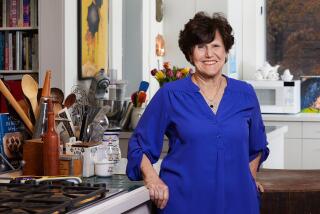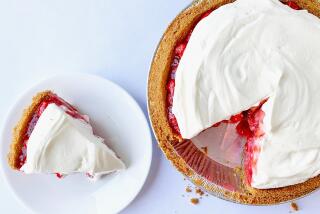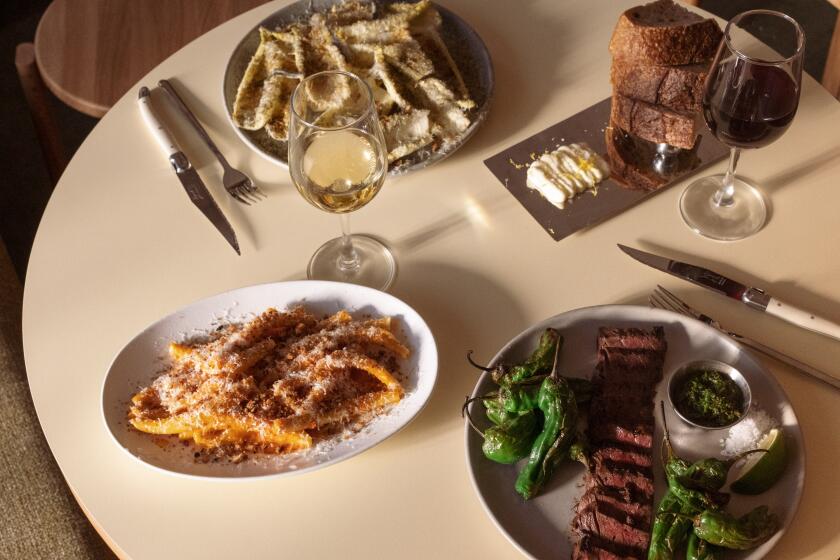The Ritual of Plum Pie
When Nancy Becker moved on a whim from New York to fruit tree-rich Oregon in 1975 at the age of 23, she could never have guessed she would meet her life’s mate, gather up some missing pieces of her family history) and rebuild a holiday culinary tradition.
These days, Becker, a registered dietitian, and her husband, Ed Reckford, and their two boys, Jacob, 11, and Louie, 7, celebrate the Jewish New Year, Rosh Hashana, by making zwetschgenkuchen.
For anyone familiar with the delicious rich plum pie, a south German and Alsatian specialty served during the fall holidays, this might seem at odds with her work, which specializes in heart disease prevention and low-fat cooking. But Becker’s yearly ritual is much more than simply baking; it is the culmination of a long and memory-laden journey.
For years, every Rosh Hashana, three generations of redheads--grandmother Elizabeth Levy, mother Ellen Becker and, as soon as she was old enough to help, granddaughter Nancy--made zwetschgenkuchen for dessert. The open-face pie is made with Italian or prune plums that ripen in September in a sort of swan song of summer fruit. Unlike American-style pies that are often overly sweet, zwetschgenkuchen packs a powerful tart-sweet punch that almost explodes in the mouth.
“Growing up, I had no idea it existed outside our family,” remembers Becker. She just knew that every year she could count on her mother to pat muerbeteig (a cookie-like tart dough) into pans, layer in ripe plums and bake at least a half-dozen of the intensely flavored pies.
Becker’s grandmother Elizabeth brought the old ways with her when she finally fled Kaiserslautern, Germany, in 1939 with her 16-year-old daughter Ellen and sister Margot.
Part of the wealthy Jewish class, the Levys didn’t believe until the last moment that their cigar factory would be confiscated by the Nazis, that they would be persecuted so ruthlessly, their very lives in jeopardy. They had lingered so long that the German quota to the United States was full, but eventually they were all able to make their way to New York.
There, Otto Becker met Ellen on a blind date; their similar south German backgrounds were a powerful bond. They married and enjoyed a comfortable life in New York with children Nancy and Jim, celebrating the Jewish holidays in a blend of Ellen’s German-Jewish traditions and Otto’s all-American ways.
Ellen began to teach Becker to make zwetschgenkuchen. “I remember my mother showing me how to make the crust. I can still see the egg going into the well of flour. Our family always made the muerbeteig crust. There was also a heifeteig, or yeast-dough version, but my grandmother was too delicate to spend all that time kneading, so muerbeteig was the recipe handed down.”
Just when Becker had begun to master the art herself, the lessons half taught, tragedy struck. Her grandmother and mother died within two months of each other.
Ellen Levy probably assumed that there was all the time in the world to tell her stories, put together albums and write down recipes to pass on to her daughter, but there are gaps in Becker’s knowledge of her family history and a shortage of old photos.
When, after college, Bronx-bred Becker headed to Oregon, a state justly proud of its produce, she found fruit trees everywhere, even on city streets and in backyards. That first September, Becker was overwhelmed to see the proliferation of purple plums.
“I immediately made the connection that these were the zwetschgenkuchen plums.” Memories came flooding back of the High Holy Days, the welcoming of the Jewish New Year. Becker began to keep a lookout for bakeries and clipped recipes for plum tarts. They were never quite right, and she gave up.
But if she couldn’t have the kuchen, at least she would have the plums. As soon as she bought a home in 1979, she planted her own plum tree. Soon after, a friend brought her a copy of Joan Nathan’s “Jewish Holiday Kitchen” (Schocken, 1979). Becker turned to the section on Rosh Hashana and there it was, page 92, “Plum Pie (Zwetschgenkuchen).”
“I had never even seen the word in print before,” Becker remembers. “It was jarring to learn that our family favorite was a regional specialty. Now references to it jump out at me everywhere. Ursula Hegi even wrote about it in ‘Stones from the River’ [Simon & Schuster, 1994; a best-selling novel on the Holocaust].”
Nathan’s recipe was almost identical to the taste and technique Becker remembered. “I made a couple of changes. My mother never used cinnamon or nutmeg and she always used butter. But otherwise, it was the real thing.”
Becker, who co-wrote and co-produced the nutrition education video, “Low Fat & Fast! Real Food for Busy People,” tried adapting the recipe to her low-fat ways. “I even tried Marion Burros’ New Age Plum Torte (“Eating Well is the Best Revenge,” Simon & Schuster, 1995) that substitutes pureed banana for some of the butter. It was good, but it wasn’t zwetschgenkuchen.”
Becker found it hard even to eliminate the egg yolk. “I just felt too good making it exactly the way my mother did.” Since that discovery, every fall Becker makes half a dozen or so zwetschgenkuchen, storing some in the freezer for a winter treat.
A few years ago, her cousin Janet, Margot’s daughter, made the pilgrimage from Philadelphia to spend an emotional afternoon making plum pie the way their mothers used to all those years ago.
Becker, Ed and the boys no longer live in the house with the plum tree. But their neighbors across the street have a tree. Each September, she picks--sometimes it’s a family project--enough plums to make zwetschgenkuchen for her family and the neighbors.
As the ripe plums fall into her hands, memories of her childhood, her mother and grandmother fill Becker with contentment. She has no problem suspending her self-imposed, low-fat standards when she bakes zwetschgenkuchen. Sometimes a sliver of plum pie is just what the heart needs.
* Saltsman is a Los Angeles free-lance writer.
*
ELLEN LEVY BECKER’S PLUM PIE (Zwetschgenkuchen)
This recipe is adapted from “Jewish Holiday Kitchen,” by Joan Nathan (Schocken, 1988).
MUERBETEIG CRUST
1 cup flour
1 tablespoon sugar
1/2 cup pareve margarine or butter, cut into pieces
1 egg yolk, optional
Salt
Brandy
FILLING
3 pounds Italian plums, washed, quartered and pitted
1/2 cup sugar
1 teaspoon grated lemon zest
2 tablespoons flour
1/3 cup currant jelly
1 tablespoon brandy
MUERBETEIG CRUST
Mix flour and sugar. Using food processor or pastry blender, cut in margarine until mixture resembles coarse crumbs. Add egg yolk, dash salt and dash brandy to moisten crust. Do not over-process.
Gather dough into ball and turn out onto board. Knead briefly. (This step is unnecessary with food processor). Place dough in center of 9-inch pie plate and pat it thinly into bottom and sides of pan. Refrigerate.
FILLING
Place plums in bowl. Add sugar, lemon zest and flour and toss gently to coat.
Spread currant jelly on Muerbeteig Crust and sprinkle with brandy. Place plums, cut-side up, around in circle on crust so that each overlaps the other and eventually forms spiral in center.
Bake at 375 degrees 40 to 50 minutes until crust is golden brown and plums are juicy.
6 to 8 servings. Each of 8 servings contains:
325 calories; 171 mg sodium; 0 cholesterol; 13 grams fat; 50 grams carbohydrates; 3 grams protein; 1.02 grams fiber.
More to Read
Eat your way across L.A.
Get our weekly Tasting Notes newsletter for reviews, news and more.
You may occasionally receive promotional content from the Los Angeles Times.









